
Steamboats in Murals
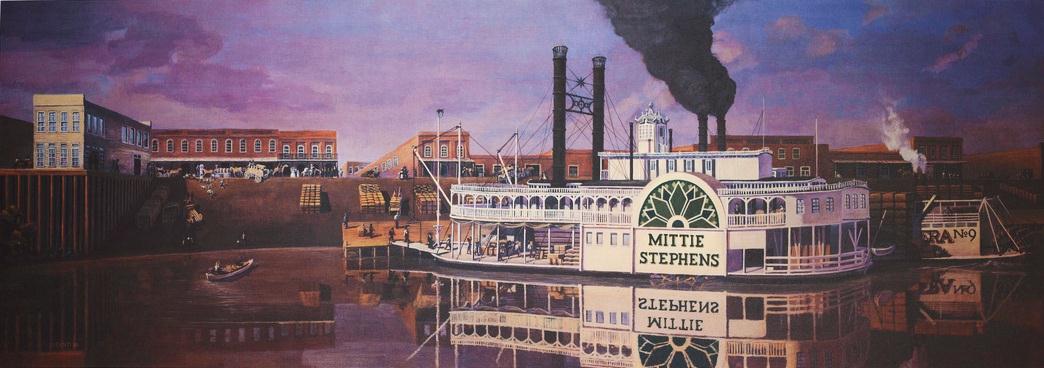
Bryan Boyd's painting of the MITTIE STEPHENS & Suzy Guese's photo of the Auntie Skinner's Riverboat Club mural
Introduction to Bryan Boyd's painting "JEFFERSON TEXAS, 1868":
Thirty years ago, right before his 26th birthday, Bryan Boyd conceptualized an idea that would take him the next ten months to complete.
It was a dream inspired by our East Texas history that included one of his favorite local towns, Jefferson Texas. He became inspired to recreate a scene out of history. The Mittie Stephens was a steamboat that would occasionally dock in Jefferson with passengers and cargo on board.
Bryan eventually learned that there was really no visual records of the historical event. He set out to research and recreate this moment in time.
(For the full text of the article and accompanying illustrations visit this link): 2bimaging-design.com
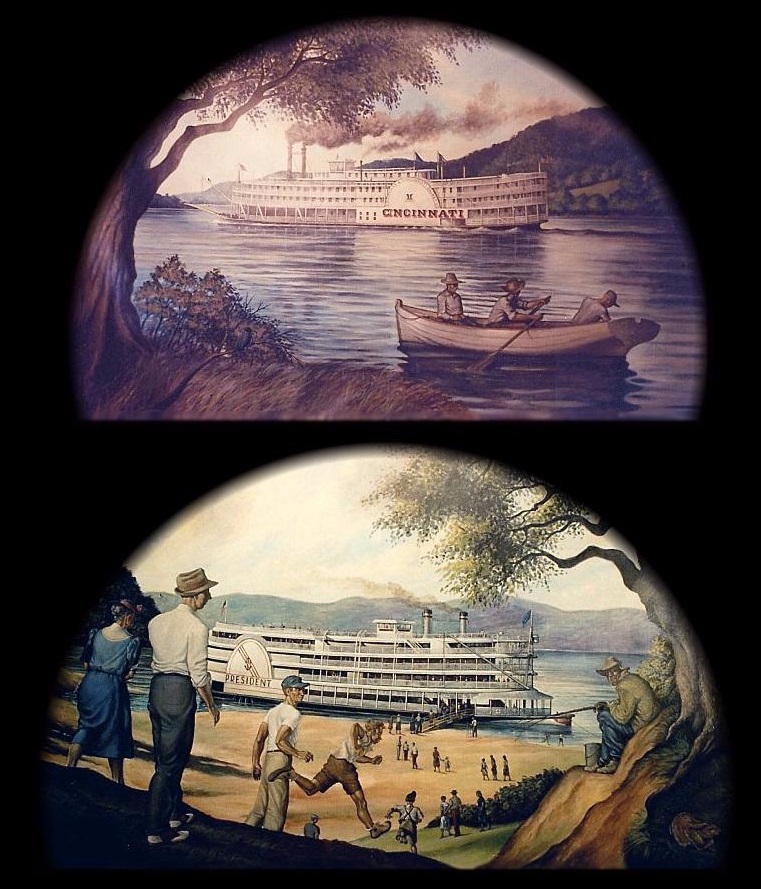
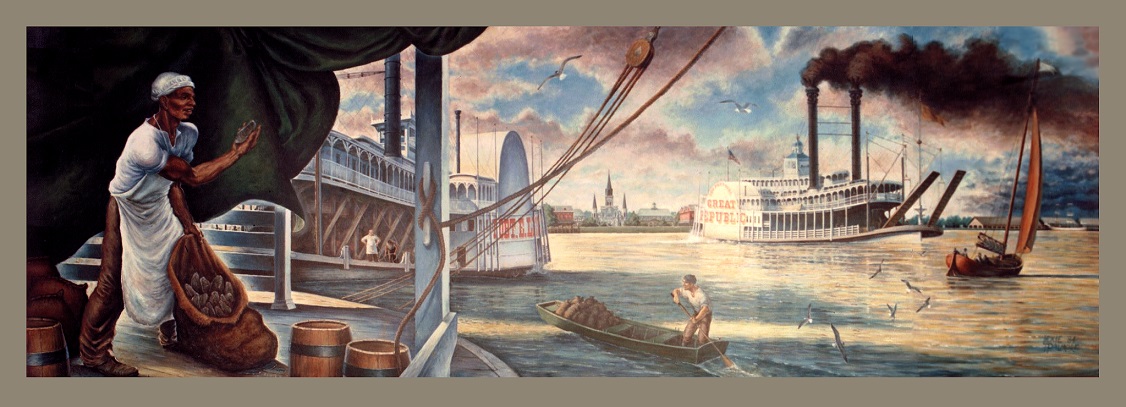
3 steamboat themed murals by artist and steamboat pilot LEXIE PALMORE!
The CITY OF CINCINNATI 8' x 5'
The PRESIDENT 8' x 5'
The ROB'T E. LEE and the GREAT REPUBLIC at New Orleans in the Oyster Bar at Case's Restaurant 6' X 18'
To find more murals by Lexie Palmore, go to her site: lexiepalmoreartist.com
To find more artwork and information at this site: Lexie Palmore at Steamboats.com.
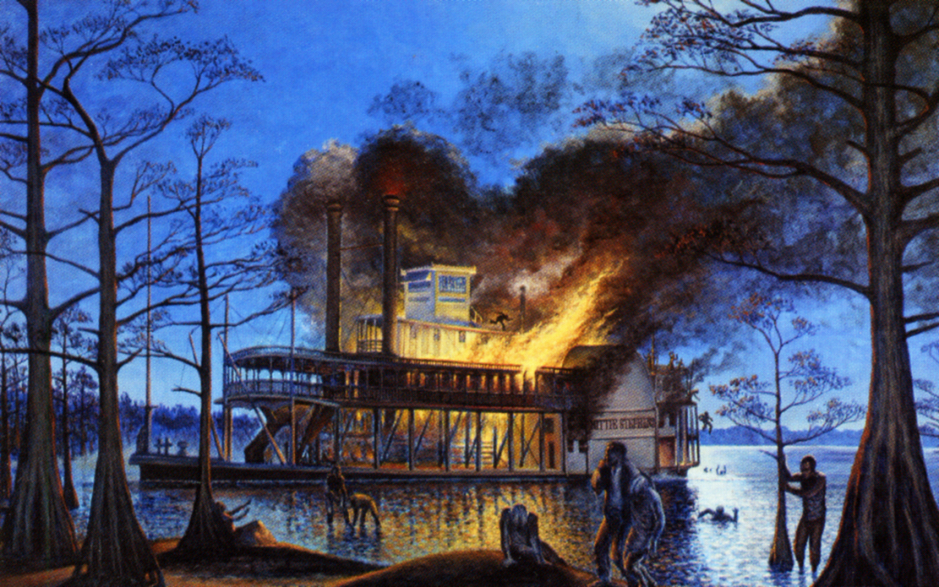
Do not panic - this is not a mural! It's an illustration of the tragic end to the MITTIE STEVENS. The sidewheel steamboat was destroyed by fire on Caddo Lake in East Texas in 1869. Painting by Lexie Palmore McMillan.
This painting appeared on the back cover of SETTLERS OF THE WESTERN WOODS by Steve Hartz. The book includes a CD of recorded Oldtime Fiddle music performed by Steve Hartz and friends.
Settlers of the Western Woods
Amazon.com
Wondrous Tales & Oldtime Musical Excursions From the World of Early Texas by Steve Hartz 2012 with Compact Disc of vintage music - on the last track (Number 25) Billy in the Lowground/Cattle in the Cane Brakes behind the fiddle music the recorded sounds of Lexie Palmore's steamboat the LONESOME GHOST with whistle blowing; engine and paddlewheel chugging along on Caddo Lake
More Steamboat Mural History
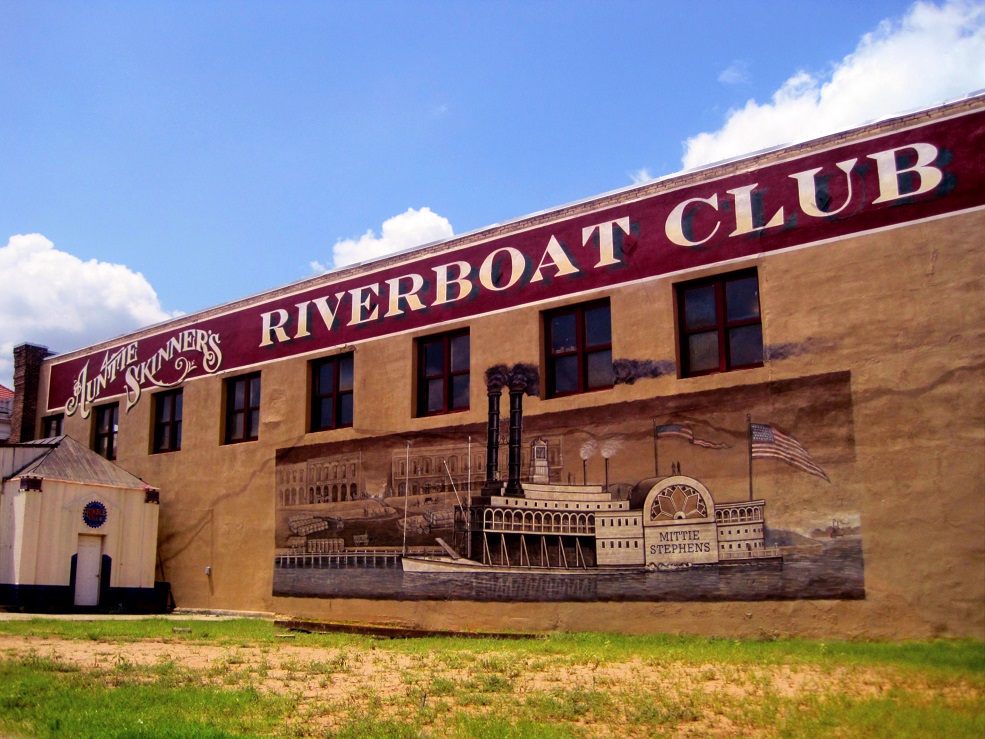
Photo by Suzy Guese of a mural featuring the ill-fated steamer MITTIE STEPHENS on an exterior wall of Auntie Skinner's Riverboat Club, a restaurant and bar in Jefferson, Texas on the Big Cypress River where steamboats traveled between the town and New Orleans.
"Rollicking watering hole in a converted 19th-century warehouse with pub grub amp; music on weekends."
107 West Austin Street
Jefferson, Texas 75657
(903) 665-7121
Riverport to the Southwest
jefferson-texas.com
Welcome to the City of Jefferson, Texas, "Riverport to the Southwest." At a time when steamboats plied the Big Cypress River from the Port of New Orleans, true Southern gentility was the order of the day. This sense of timelessness prevails even unto today. Let yourself be whisked away to a land not far away as you glide peacefully along in an open-air riverboat where Jefferson's colorful past comes alive.
THE MITTIE STEPHENS DISASTER
texasescapes.com
by Archie P. McDonald, PhD
On February 12, 1869, a fire burned the MITTIE STEPHENS to the waterline in Caddo Lake.
Robert Fulton won the technological race to find a way to utilize steam power for transportation when he successfully sailed the Clermont on the Hudson River 1807. He did not solve another problem: how to make such travel safe.
When we remember steamboat accidents, most of us think about boiler explosions, which resulted from excessive pressure or faulty equipment, or both. But the boiler was working well on the side-wheeler MITTIE STEPHENS on February 12, 1869, and did not explode: instead, a fire burned her to the waterline in Caddo Lake near the Texas-Louisiana border.
Steamboats became pervasive on America's inland waters during the first half of the nineteenth century. Moving passengers and cargo over water was also slower. But with only animal powered wagons, and after 1837 the "iron horse" railroads as competitors, steamboats proliferated and their owners prospered. Still, there was danger on the water.
The MITTIE STEPHENS came out of a shipyard in Madison, Indiana, in 1863, in time to be a part of the effort to preserve the Union. She served as a naval packet for a year, but after the failure of the Red River Campaign in 1864 she was sold. Civilian owners used her on the Missouri River and then stationed her in New Orleans.
In 1866, the STEPHENS began regular round trips between New Orleans and Jefferson, Texas, via the Mississippi and Red rivers and Cypress Bayou. Her last voyage began on February 5, 1869. Seven nights later, she steamed on Caddo Lake near her destination with 107 passengers and crew, plus cargo, which included hay stacked on deck. Sparks from a torch basket located on the bow to illuminate the ship blew in the wind to the dry hay, ignited, and a conflagration resulted.
The helmsman steered for shore but the ship "grounded." That meant that passengers might have saved themselves by jumping overboard and wading to shore. But the side-mounted paddlewheels kept turning in an effort to force the ship on to shore, and many who leapt overboard were sucked into the wheel. Sixty-one people perished.
The STEPHENS burned to the water line, though parts of her, including the bell, and some machinery, were salvaged. Her remains remind those who visit the lake of the dangers that await those who move upon the waters well into the twentieth century.
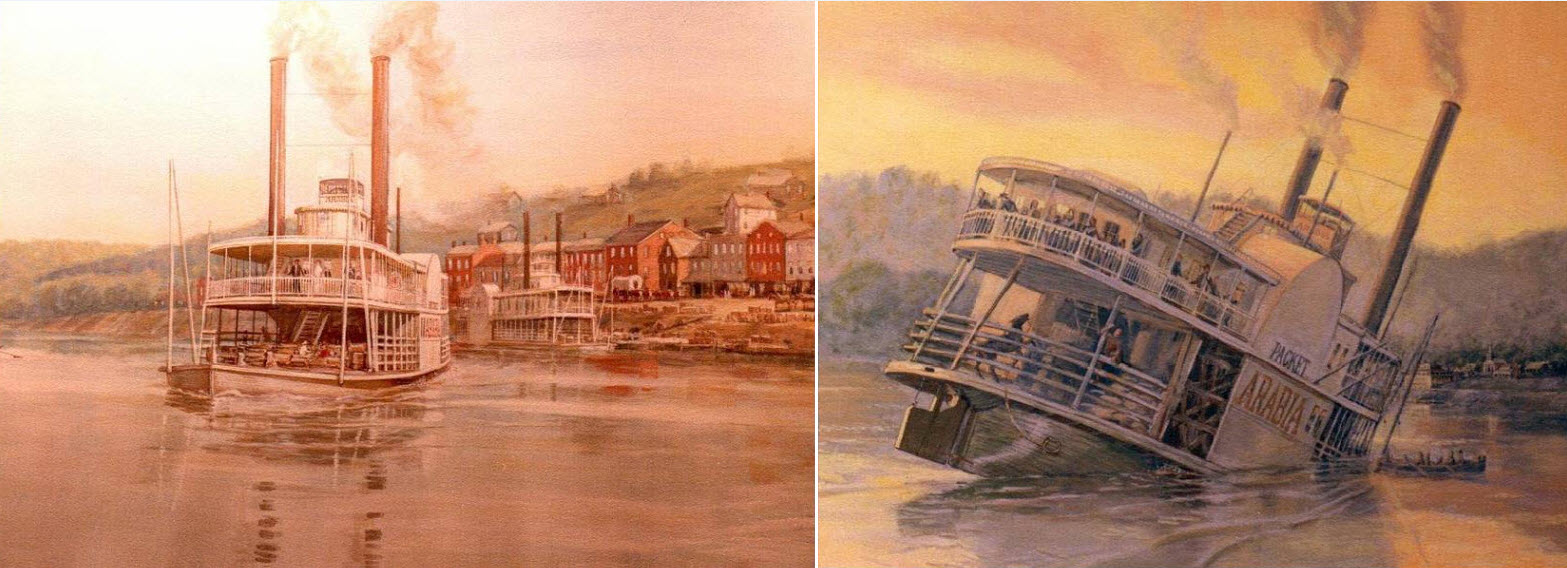
I took these photos of murals at the Arabia museum when I visited during the 1990's. The steamboat Arabia sank in the Missouri River near Kansas City on September 5, 1856, carrying 200 tons of cargo. Lost for 132 years, she was unearthed in 1988. Well preserved clothes, tools, guns, dishware have been salvaged and are on display along with the engines and other remains of the boat itself at the Arabia Museum in Kansas City. Their website is 1856.com.
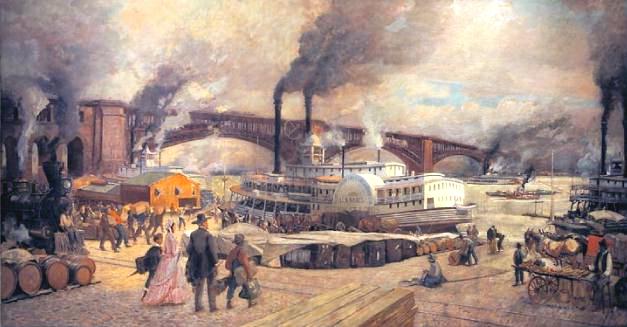
Artist O.E. Berninghaus painted a mural of the St. Louis levee (above) upon which he based his panoramic promotional art for the Anheuser-Busch company (below)
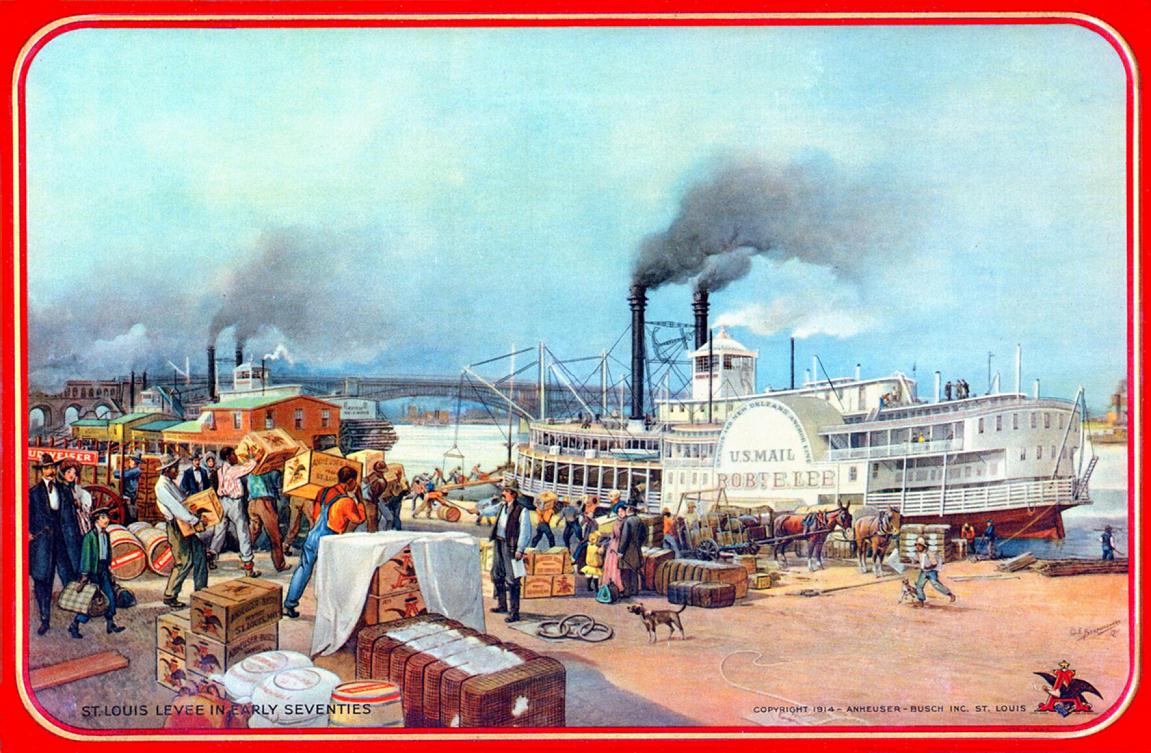
1914 Anheuser-Busch also produced a serving tray which Berninghaus himself apparently refined and smoothed down from it's appearance in the panoramic lithograph, brightening the colors and extending the sky to fill the tray's rectangular format.
On Apr 16, 2016, at 1:22 PM, John R. wrote:Editor's Note: Thank you John for this information!
This passage is incorrect:
1914 Anheuser-Busch also produced a serving tray which Berninghaus himself apparently refined and smoothed down from it's appearance in the panoramic lithograph, brightening the colors and extending the sky to fill the tray's rectangular format.
I thought I would pass on my knowledge of this tray, as I am a collector.
The artwork is copyrighted 1914, but the tray was produced post prohibition in the 1930's.
trayman.net
Also the original artwork did not carry as many AB logos, they were added later. I know because I have a copy of the original 1914 AB booklet "Epoch Marking Events of American History".
In 1914, a year after his wife died of diabetes, the Anheuser-Busch Brewing Company release a promotional booklet titled Epoch Marking Events of American History that was composed of billboard illustrations that Berninghaus had previously completed for the company. The book included 10 paintings by the artist featuring historical events important to the American West, including Hernando de Soto's founding the Mississippi River, Jacques Marquette's descending the same river, Pierre Laclède's founding of St. Louis, a scene from the Lewis and Clark Expedition, John C. Frémont, a pioneer wagon train on the Salt Lake Trail, and a Union Pacific train.[3] Berninghaus painted a number of paintings for the Busch family throughout his lifetime, many of which were donated to the St. Louis Art Museum.
Wikipedia
Just an FYI, I enjoyed perusing your site.
All the best!
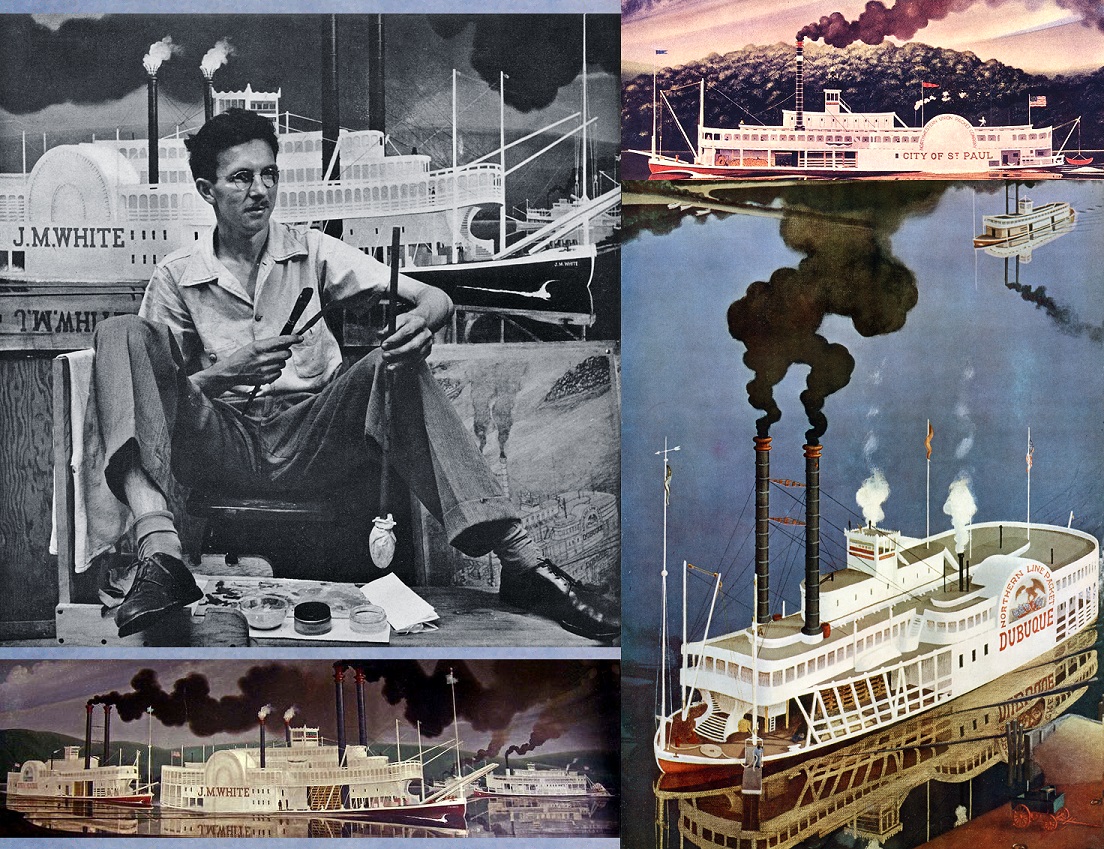
FROM ARCHIVES OF AMERICAN ART:
aaa.si.edu
William E. L. Bunn (1910-2009) was a designer, muralist, and painter in Ft. Madison, Iowa and Ojai, California. Bunn was born in Muscatine, Iowa and received his B.A. in Graphic and Plastic Arts and an M.A. in Theater Design, both from the University of Iowa.
In 1937 he was awarded a one-year post-graduate fellowship as an art intern for Grant Wood.
From 1938 to 1942 he won four commissions from the Treasury Department to produce murals for Federal buildings.
He also exhibited paintings, primarily depicting Mississippi River steamboats, at the National Academy of Design, Art Institute of Chicago, Pennsylvania Academy of Fine Arts, and other group shows.
Beginning in 1943 Bunn worked as an industrial designer at several companies including Sheaffer Pen Company (1946-1967) and Cuckler Steele Span Company (1967-1977).
After his retirement, he and his wife, Annavene, moved to California, and he continued to paint. Bunn was also active in the Theosophical Society and had an interest in aviation.
LIFE magazine featured two photos of William Bunn (one is included above) and his majestic steamboat paintings the October 14, 1940 issue. Below is the text from that "Art" feature. The mural entitled MISSISSIPPI PACKETS was a work in progress (J.M. WHITE at center) behind Bunn at his studio in Iowa City, Iowa in the photograph and it was installed in 1940 in the U.S. post office in Hickman, Kentucky. The completed work is in the lower left. A mural of a head-on view of the steamboat DUBUQUE painted in 1936 is in the U.S. post office at Dubuque, Iowa. In the LIFE issue there are three color images of Bunn's paintings, two of those are presented on the right. A "study" drawing of the high angle view of the DUBUQUE (in color on the right) can be seen behind Bill's left leg in the photo.
LIFE magazine 14 October, 1940
WILLIAM BUNN'S MISSISSIPPI STEAMBOATS RECALL THE GLORIES OF BYGONE DAYS
"When I was a youngster," says Painter William Bunn who grew up in Muscatine, Iowa, "my buddies and I always headed for the river after school. We would row across to the Illinois shore or out to Towhead Island where Mark Twain used to play as a boy. We absorbed all the sights and smells and sounds of the Mississippi it was the one great dominating influence of my life."
This river influence had made Bill Bunn at 30 a specialist in painting old time Mississippi steamboats. His murals are to be installed in Iowa and Kentucky, and next year he will hold his first one-man show in New York City.
Bunn's boats evoke a vanished era in American life when the great floating palaces set a standard for elegance. They served the finest Southern cooking. At night as the dark shores slipped by, their decks were aglow with lanterns and passengers danced to banjos. In the sunlight they glistened like wedding cakes with their gilded gingerbread. Almost every trip brought adventure. There were gamblers aboard. Courtships flourished in the long lazy days. Rich planters, who were given free trips as a bonus for their shipments, sometimes took their wives, sometimes did not. Once in a while one of the boats exploded and burst into flame. At the end of the run, gay as a foreign capital, was New Orleans.
With a historian's zeal, Bill Bunn reconstructs his steamboats from old drawings and photographs or from boat-builders' original plans. He paints them in a clean, ship-shape style that shows his five years of study with Grant Wood in Iowa City. This month Bunn and his 19-year-old wife will sail their own boat from Lake Itasca, where the Mississippi begins, 2,500 miles down to New Orleans. If they run out of money, Bunn says he will do portrait sketches on the way or set up his portable Punch and Judy show and perform for youngsters along the river front.
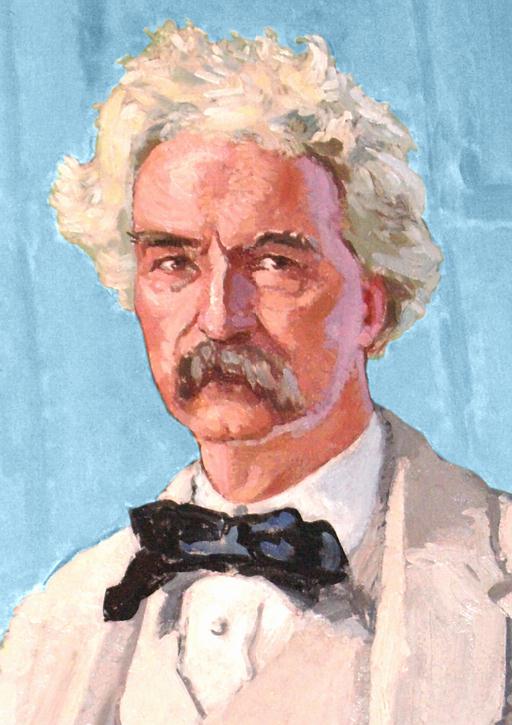
Detail of the Mark Twain mural in the Missouri Governor's office.
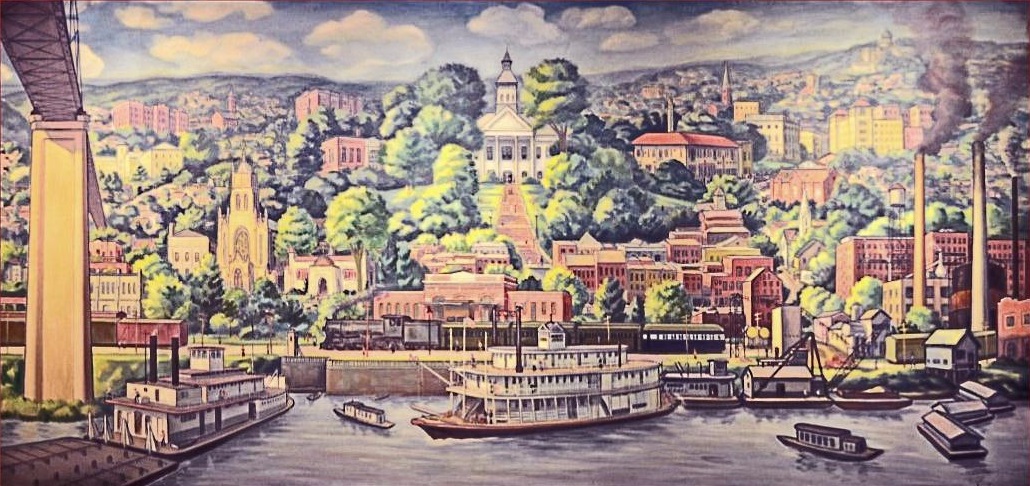
The 1940 WPA mural of the Mississippi river city of Cape Girardeau entitled "METROPOLIS" attracted my attention because of the towboat in the lower left and the packet boat lower center on a current postcard promoting the Missouri Preservation Conference to be held in Cape Girardeau in October, 2015. I contacted Missouri Preservation and both Katie Graebe and Bill Hart responded to my inquiries. Bill's comments below:
Cape Girardeau as it was appeared in the mural METROPOLIS in 1940, was created as part of a WPA project. Today, some of the buildings are missing, but very many of these structures still exist. Of course the river port is no longer filled with so many boats and so much activity. The train depot (red brick in the center) is gone, as well as the factory building in the far right. The old St. Francis Hospital in the far left at top is gone, as is the old bridge, which was pretty new at the time of the painting.
But the Court of Common Pleas, top and center is still there, as is the building to its right, the Southeast Missourian Building. Going right from there, the Marquette Hotel (just to the left of the smoke stack smoke) is still there, and just above, the domed Academic Hall at Southeast Missouri has recently been renovated. Coming down the hill from the old Marquette Hotel, the Presbyterian and Lutheran church buildings are still there. To the left of the old train depot are the B'Nai El Temple and St. Vincent's Cathedral, both of which are still shining.
Bill Hart
Executive Director
Missouri Preservation
Located in the Historic Katy Depot
320 First Street
Boonville, Missouri 65233

In 2004 Ed Garbert (1928-2015) and I used our computers to create this panoramic re-creation of how we speculated Hannibal, Missouri probably looked in July of 1848 based on drawings made by English artist Henry Lewis (1819-1904) when he traveled down the Mississippi River from St. Paul to New Orleans sketching rivertowns and cities. Returning to England Lewis used his own sketches as reference to paint with the help of assistants, a huge touring panorama of the Mississippi River that he presented as a narrated traveling show in European cities. The long canvas was 12-feet-high by 1,250 yards long that was exhibited by cranking the "panorama" from left to right between vertical rollers and was lit by the stage footlights of the time. Lewis also made 80 individual color lithographs of selected rivertowns, cities and scenic landmarks that were published first in an 1854 German edition entitled VALLEY OF THE MISSISSIPPI ILLUSTRATED and later in an English edition.
Steve Railton at the University of Virginia has included our panorama in the portion of his Mark Twain site devoted to Sam Clemens, Hannibal, MO and how Mark Twain's memories of the town and the Mississippi provided the inspiration for the adventures of Tom Sawyer, Huckleberry Finn, Pudd'nhead Wilson as well as anecdotes that he included in his correspondence, his travel books and his autobiographical writings.
virginia.edu
According to Dave Thomson, this representation of Hannibal is based on Henry Lewis' sketchbook pages of 31 July 1848:
"The panorama was done in the style of a post office mural from the Depression-era WPA. The white building above the steamboat paddle box represents the office of Justice of the Peace J. M. Clemens (Sam's father). The Clemens family lived one block further back from the river.
"Using the 1854 map of Hart and Mapother as well as Ruger's 1869 bird's eye view I determined as closely as possible the materials the depicted buildings were made of, brick predominating with the white and gray buildings constructed from wood. The buildings on the far left are the pork slaughtering and packing business. The building on the far right I believe was a sawmill. Other pork packing businesses and a tobacco factory most likely occupied the neighboring buildings on the far right. The other brick structures would have been occupied by hostelries, merchants and tradesmen, warehouse facilities, & Co. As a foreground focal point I added the steamboat "Missouri" (aka the "Big Missouri"), which operated on the Mississippi from 1845-1851. The "Big Missouri" is the boat Ben Rogers "personates" in Chapter 2 of Tom Sawyer.
"The image was colorized with the help of my friend Ed Garbert. We put the light source in the east, as the village would appear in the morning (and since the town is laid out at a northwest to southeast angle parallel to the river, this is how the buildings are lit to best advantage). Ed 'painted' the majority of the buildings with a Photoshop program and I modified the foliage, added the steamboat and modified the color scheme.
"The National Geographic article 'The Mighty Mississippi' (1971) reproduces the two pages from Lewis' sketchbook on which this picture is based. My original black and white rendering of this scene was featured on the cover and fly leaves of Hannibal Too, by Hurley and Roberta Hagood (1986)."
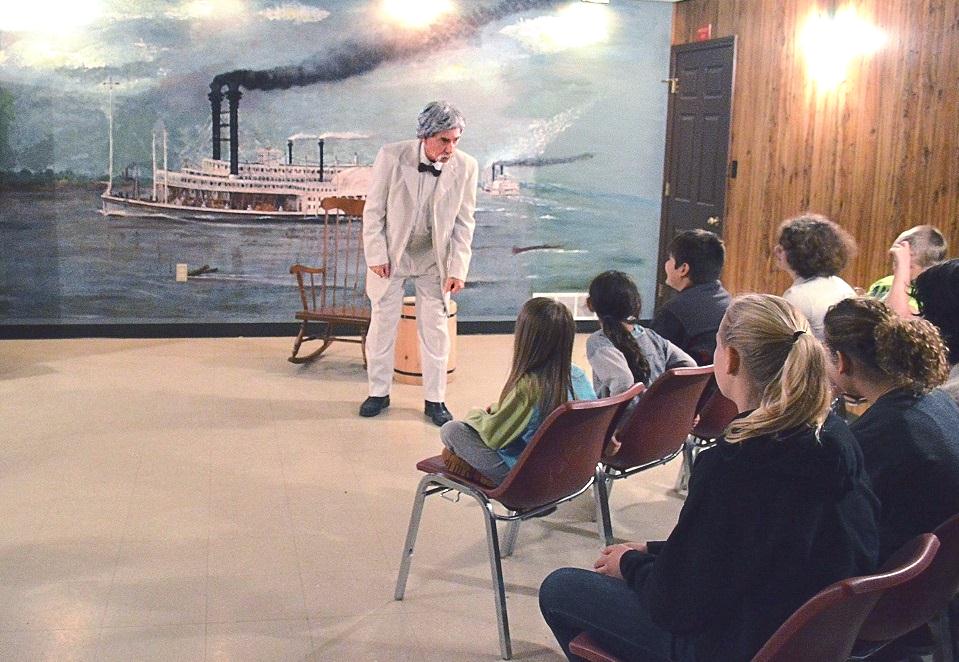
Jim Waddell giving his orientation talk to school kids who were bussed over to Mark Twain Cave for a Tour. The mural behind him is an enlargement of a super high resolution Library of Congress file of a steamboat painting (seen above, by August Norieri) that lends itself well to the environment of this room where the tourists of all ages get an introductory talk prior to going on the tour of the Cave. For more Jim Waddell, click here.
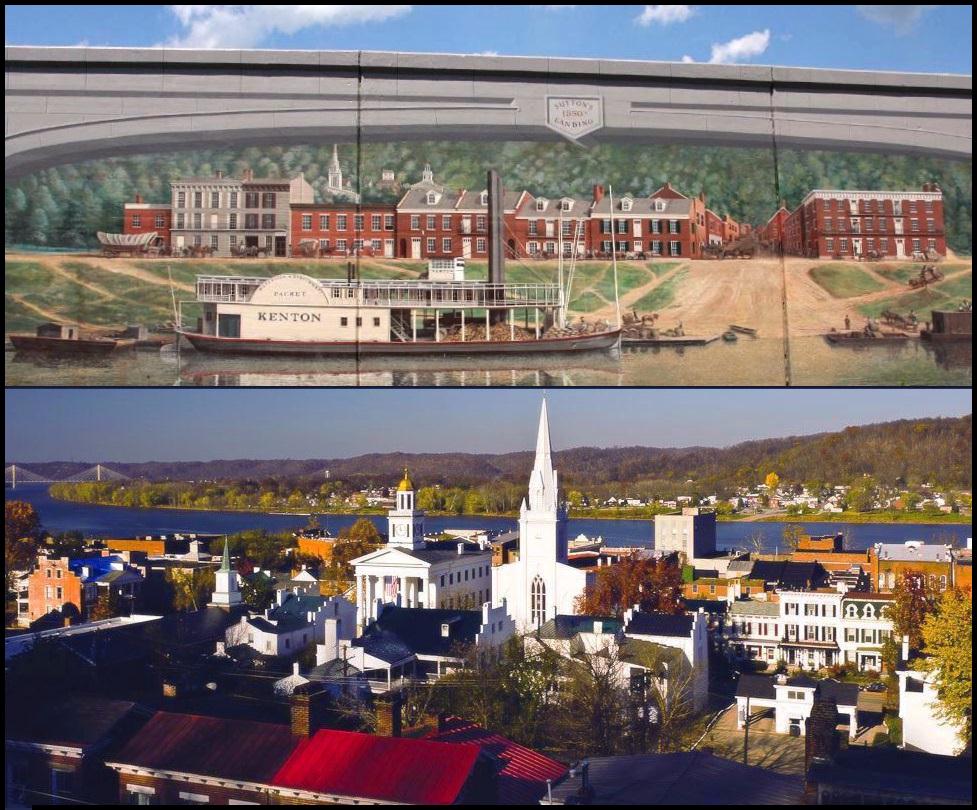
Maysville Kentucky Flood Wall mural with Steamboat KENTON at Sutton's Landing during the 1850's
Have been to Maysville, Kentucky a number of times and was always very impressed with the state of preservation there, so many wonderful vintage structures downtown and in the outskirts.
At the museum there is a diorama that includes a scale model of steamboat KENTON at Sutton's Landing which must have inspired the Flood Wall mural in the attached photo with the KENTON at the Landing during the 1850's.
These photos two came from different online sources. I haven't been back to Maysville since 1993 so I've not seen the 10 murals which the "Sutton's Landing" is seen in the top photo painted by Robert Dafford.
Wikipedia
Maysville became an important port on the Ohio River for the northeastern part of the state. It exported bourbon whiskey, hemp and tobacco. It was once a center of wrought iron manufacture, sending ironwork downriver to decorate the buildings of Cincinnati, Ohio, and New Orleans, Louisiana.
Other small manufacturers also located early in Maysville and manufacturing remains an important part of the modern economy.
Under the leadership of Henry Means Walker, Maysville was home to one of the largest tobacco auction warehouses in the world for most of the 20th century.
Maysville was an important stop on the Underground Railroad, as the free state of Ohio was just across the river.
Abolitionist author Harriet Beecher Stowe visited the historic district of Maysville in 1833 and incorporated her experiences there into her novel, Uncle Tom's Cabin, published in 1852.
cityofmaysville.com
Floodwall Mural Project
McDonald Parkway
Maysville, KY 41056
606-563-2596
info@maysvilleky.net
The Maysville Floodwall Mural project began in the summer of 1998.
The early river history of Maysville has been created on the floodwall through murals created by Robert Dafford of Dafford Murals from Lafayette, Louisiana.
SUTTON'S LANDING 1850s Summer time; the river bank along Water Street, was the original name for Front Street.
The banks are lined with various modes of wheeled transportation that included a side wheeled steam boat, stage coaches, ox carts and drays of every description.
The buildings which face the river are of brick construction and show predominance of new houses in the area.
As a result of the floodwall construction and urban renewal projects, an entire block of Federal-period architecture was demolished.
Note the passage arches at Cox's bookstore. It is said that one of the buildings on this block had a peephole and a hidden room for 'hiding the priest' from anti-Catholic elements of the 'Know-Nothing Party.'
Keep in mind these buildings were built for shipping business.
The three storied building on the left, known today as The Lee House, what was originally named the Washington Hotel, was built circa 1798. Famous guests include Henry Clay, the Marquis de Lafayette and Andrew Jackson. (The original guest register is on display at the Kentucky Gateway Museum Center). After a complete renovation, the Lee House has been changed into upscale apartments.
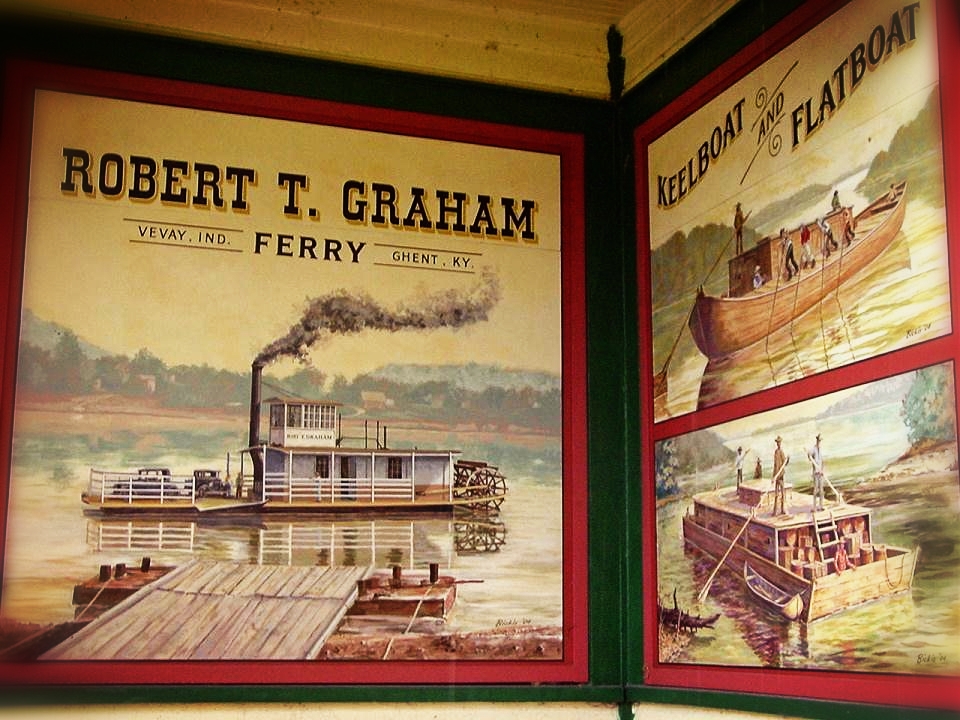
Murals outside the River Museum in Vevay, INDIANA
featuring the ferry ROBERT T. GRAHAM and the pioneer modes of river travel before steamboats came along, the keelboats and flatboats. Photo from unknown source.
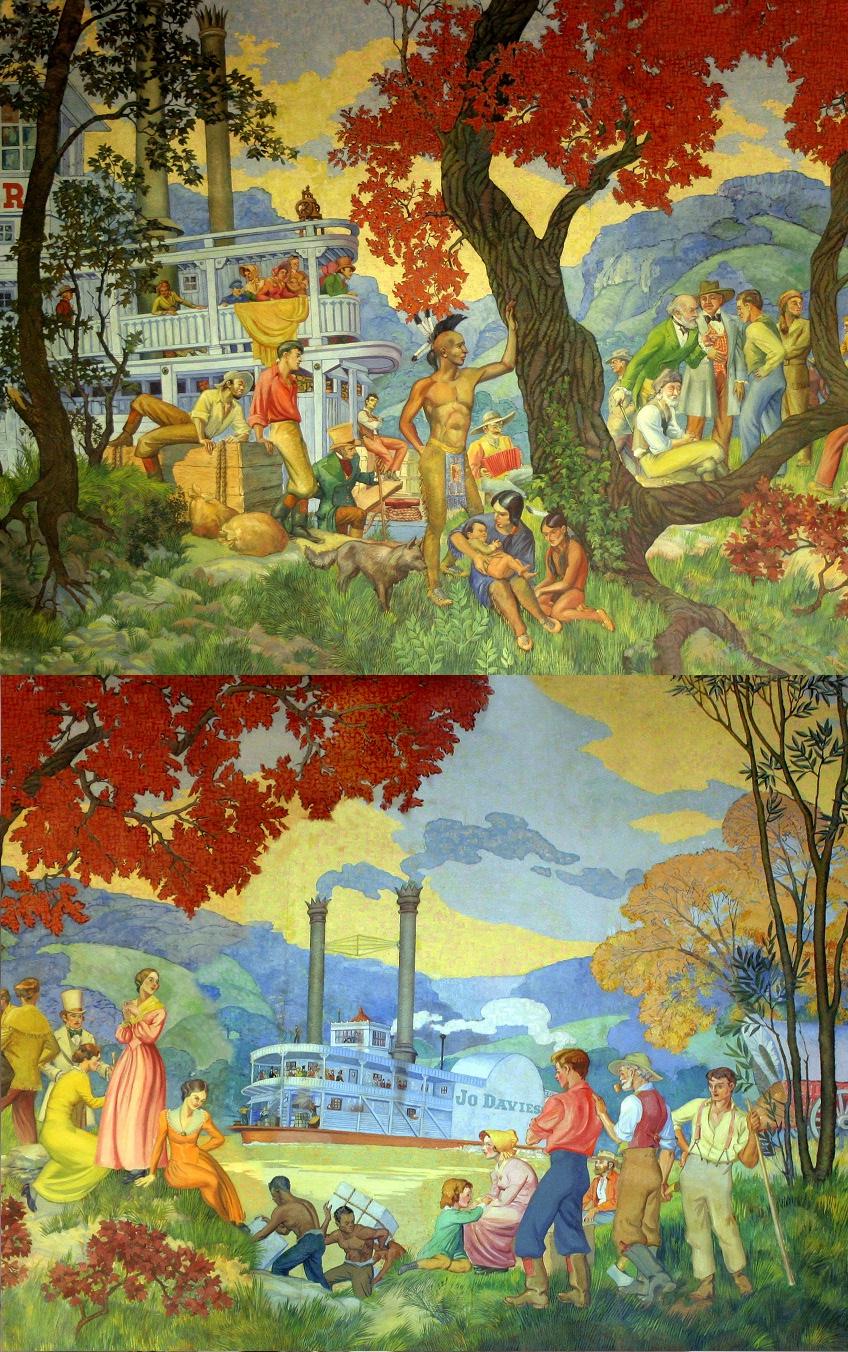
Details that include steamboats from a 1930's mural by Dubuque artist C.P. FERRING
Details from an incredibly well painted in 1930's mural in a High School Auditorium in Dubuque, Iowa.
garyolsen.com
An example of one of the Depression era Murals by local Dubuque artist C.P. FERRING in the Lamb-Hedeman Auditorium on the campus of Senior High School in Dubuque, Iowa.
The large mural that includes two steamboats is a splendid example of regional painting style made famous by Thomas Hart Benton and Iowa artist Grant Wood.
African American roustabouts are depicted unloading supplies on the riverbank to a wealthy family supervising the construction of a steam powered sawmill that was depicted in another mural. The examples above are taken from the long panoramic mural of steamboats and folks on shore have been taken from the left and right halves of the composition.

With the exception of images credited to public institutions,
everything on this page is from a private collection.
Please contact Steamboats.com for permission for commercial use.*
All captions provided by Dave Thomson, Steamboats.com primary contributor and historian.
